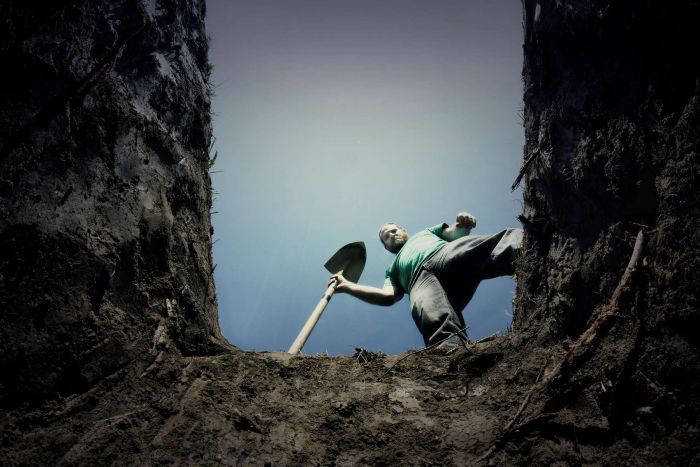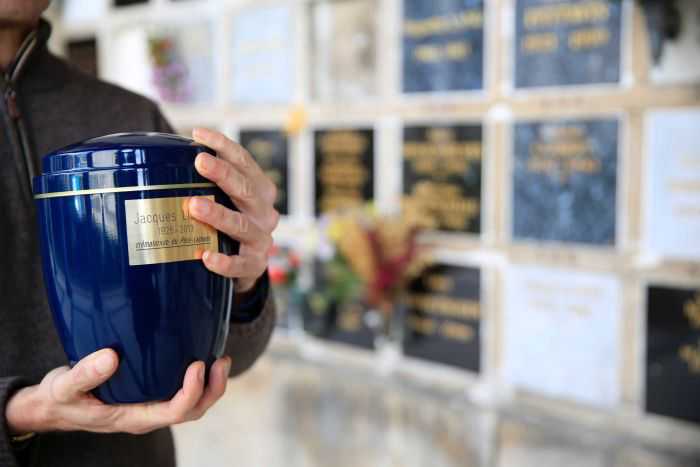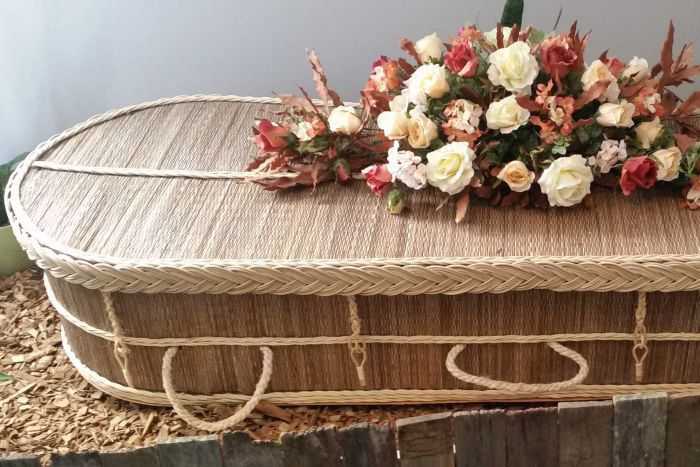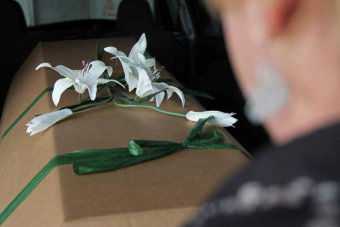Freeze-drying, shattering, dissolving: Weird ways to dispose of a body (legally)Funeral Packages
Swedish biologist Susanne Wiigh-Masak is an entrepreneur of death — and the burial system she's developed is as unexpected as it is high-tech.The process, dubbed "promession", has so far been tested only on pigs, their carcases frozen using liquid nitrogen.Once crystalline and brittle, the cadavers are shattered by a short ultrasonic vibration, until what was once a full-sized pig is reduced to a form of porcine powder. The biological pulp is sifted and freeze-dried. After being packed into a small biodegradable box, the odourless remains are placed in a shallow grave.

Pigs were chosen to test the technology because of their anatomical and physiological similarity to humans, but the ultimate goal is to use the system on people.Ms Wiigh-Masak says that will allow a more scientific and ecologically-friendly form of burial — one in which the body is readily absorbed back into nature and not left to putrify in a lacquered coffin, six feet under.There's a clear ideological underpinning to the endeavour: it's about putting the dead to work in the service of nature."What promession is offering is new life to the soil. Bringing new life to plants and flowers instead of seeing death as the final end," Ms Wiigh-Masak says.It is also being marketed as a clean energy alternative.Photo: Burial springs to mind quickly when you think about how to dispose of a body — but there are other ways. (Getty: Scott MacBride)
It uses far less electricity than cremation, Ms Wiigh-Masak says, and the nitrogen employed as part of the freezing process causes no pollution."It is a very natural product. Most people don't even know that they breathe nitrogen every day; 78 per cent of the air we breathe is nitrogen," she explains."When the gas companies are producing liquid oxygen for the hospitals, there will always be a little bit extra liquid nitrogen that they don't need."Ms Wiigh-Masak claims her organisation Promessa Organic is now ready to build the world's first working "promatorium", but the details of when and where are sketchy.And it seems they've been on the verge of launching for some time — at least since 2013.Ms Wiigh-Masak says the delay has been necessary to educate people about the system's potential.While there are doubters, the process seems to have attracted an international following, with a network of dedicated supporters in Europe and America."We are the only organisation — within the burial organisations — that has a fan club. We have a supporting team which is called Promessa Friends, and we have an interest from 95 countries in the world," Ms Wiigh-Masak says.

The problem with cremationIn most Western countries, cremation is king. In Australia, more than 70 per cent of people opt for incineration over burial. But it's a relatively new phenomenon.Cremation was rare in the developed world until the late 19th century, and only started to gain popularity after World War One, says historian and author Thomas Laqueur."Burial customs are actually very conservative. They change at a glacial pace," he says.However, as the 20th century progressed and urbanisation grew apace, incineration began to be seen as progressive, because it dramatically reduced the amount of land needed for cemeteries.But concerns over pollution and climate change have sparked a rethink among environmentalists.The average human body takes up to one-and-a-half-hours to cremate at a temperature of around 1,000 degrees Celsius, so there is a significant energy cost to cremation.And as bodies and caskets are burnt, they can release all kinds of pollutants."You've got airborne mercury coming out of the chimney," businessman Jon Humphries says."You've got carcinogenic fumes, you've got toxic fumes and particulate matter all coming out and being spread around the surrounding areas.Photo: Cremation is a common option, but concerns over pollution have sparked a rethink among environmentalists. (Getty: Godong)
A watered-down alternative — of sortsMr Humphries runs a firm called Aquamation International, which offers its own alternative to cremation, a process known as alkaline hydrolysis.Unlike promession, the system is already up and running. In the United States it goes by the names 'water cremation' and 'green cremation' and is approved and regulated in 15 states.Alkaline hydrolysis involves placing a body into a long stainless-steel container and allowing boiling water to constantly wash over the corpse until the flesh, muscle and other bodily organs liquify. A chemical catalyst, usually potassium hydroxide, is used to effect the decomposition.When the process is complete, all that is left are bleached bones and liquid human runoff. "Dissolved is technically not right," Mr Humphries says.
"It's not dissolved, it's broken down into the chemical components the body's made up from."
Mr Humphries has been offering the service in Australia for the better part of a decade, but only a few Australians have so far chosen it as an end of life option. Still, he's convinced water cremation has a viable future. Novelty aside, he says the process is no more bizarre than the idea of putting a person's corpse into an oven and interning the resultant ashes in an ornamental urn.And like Ms Wiigh-Masak, he stresses the environmental plusses. "With this process it doesn't simply reduce the enormous amount of pollution that comes from cremation and from burial, it eliminates it totally," Mr Humphries says."This is 100 per cent pollution free."The only pollution you could possibly get from it would be the generation of the electricity that actually runs the process — which is probably about a tenth of the electricity that a cremation uses."In the US, some concerns have been expressed about the disposal of human liquid. While Mr Humphries dismisses any health issues, he does admit he's not comfortable with the use of the biological waste as a fertiliser.He blames the slow adoption of the technology on a lack of competition in the funeral business. The big players, he argues, have no economic incentive to offer new alternatives to traditional body disposal practices. The University of Sydney's Sandra van der Laan, who recently co-authored a report into the Australian death care sector, agrees.
Industry concentration and the need for regulatory changeProfessor Van der Laan's research indicates around 40 per cent of the industry is concentrated in the hands of just one provider, with a consequent lack of scope and diversity in the services offered."I don't think it's part of the funeral industry's ambit to be trying new things around disposal of the dead," she says."They've built their business models on the traditional funeral services, so branching out into new industries is going to be more expensive."She says industry concentration has also played a part in limiting the uptake of "natural" burial options.Natural or "green" burials involve placing bodies in biodegradable coffins or simple shrouds. And that means you don't fill a cemetery with plastic cushions, metal coffin parts and embalming chemicals.They also do away with other traditional accoutrements of burial, such as a headstone, crypt or even landscaping.Professor van der Laan argues regulatory reform is long overdue, and has called for a harmonisation of state laws.Photo: Using biodegradable caskets avoids filling cemeteries with plastic and metal coffin parts. (Supplied: Handwoven Caskets)

Current rules and procedures, she says, have not kept pace with change and could limit future options.Crucially, she says there's also a need for greater public awareness around the choices available when dealing with end of life decisions, because grief can impede decision making."People are quite often encouraged to deal with it very quickly. For most people I think they get a bit hurried," she says."One of the problems that we have in much of Australia is that the only people allowed on to cemetery and crematoria sites are funeral directors — licensed people. But you can do a lot of that whole funeral process yourself. You can take the body home as long as you can keep it cool."Another option involves direct committal, where a corpse is taken directly from the place of death to a crematorium.Burial at sea, and on private land, is also permitted under certain circumstances."There are more choices than what we believe," Professor van der Laan says."I'm not saying that those choices are for everybody, but some people would like to have a bit more control over what happens when they're dealing with their loved ones after they've died."Photo: Cardboard coffins are a low-cost, environmentally-friendly alternative.
Source: www.abc.net.au


